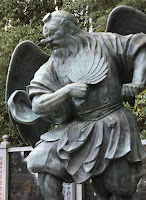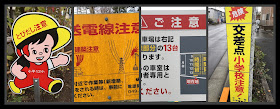 |
| Kerria Japonica (yamabuki) or Japanese yellow rose |
One of the fun things about learning a foreign language is that you realise that many words and concepts you took for granted are in fact arbitrary. A prime example is colour (
iro in
Japanese=色) and colour labels can
differ in interesting ways between cultures. For example, Japanese has
many
colour labels named after things in nature such as
kuchiba (fallen leaves)-
iro and
uguisu (Japanese nightingale)-
iro. Fruit labels are particularly common and include
daidai (tangerine)-
iro, anzu (apricot)
-iro, and
momo (peach)-
iro. Interestingly, the colour
beni-
iro although named after the yellow-orange flower
beni-bana (
safflower) is
translated as crimson in English while
yamabuki-iro
(a colour named after the bright "yellow" spring flower Kerria Japonica pictured above right which was introduced in an
earlier post) is closer to orange on
the colour spectrum in Japan - and Japanese insist the flower has an
"orange" tint!
 |
| A green (blue?) crossing sign |
Even more interesting are the colours "blue" and "green" in Japanese. While
ao(i)-iro or simply
aoi (青い) is translated as "blue" in the dictionary this doesn't capture how it is actually used in practice.
Aoi in Japanese, especially in the past, typically covered a broader spectrum than the English "blue", and is probably best described as
green/blue (grue?). Today, there remain many reminders of
this "grue" perception such as the fact that the "green" traffic
signal and walk symbol (pictured left), "green" apples, and "green" leaves are referred to as "blue" (
aoi) in Japanese. In the case of the first two, one explanation is that Japanese see red and blue, being primary colours, as opposites and using
aoi in these cases makes the contrast with red clearer.
A final example of using
aoi (blue) where we would use green in English are the words used to describe young people who in English would be "green behind the ears" or "greenhorns." In Japanese young people are
seinen (青年), adolescence is
seinenki (青年期), and puberty is
seishunki (青春期), all using the kanji for "blue." But just to add to the confusion, in the past infants up to three years-old were called
midori (green)
ko/go with the nuance of a young bud or leaf. New-born babies, however, have always been called
aka-chan or "little red one" using the character for red (赤)!



 One unusual feature I noticed on the mountain were the plethora of black balls sitting on a stone lotus plinth with a spinning wheel underneath (right). On each ball was written one of six kanji characters reflecting the six "roots" or senses: eye (目), nose (鼻), ear (耳), tongue (舌), body (身), and mind/heart (意) - the latter to interpret and judge the senses. According to the "instructions" (left) one is supposed to spin the wheel thereby reflecting on and cleansing/purifying (seijō =清浄) the self, enabling one to feel rejuvenated and look ahead to the future. In sum, climbing Mount Takao will help you to feel refreshed both mentally and physically - but be careful not to become too proud of yourself...
One unusual feature I noticed on the mountain were the plethora of black balls sitting on a stone lotus plinth with a spinning wheel underneath (right). On each ball was written one of six kanji characters reflecting the six "roots" or senses: eye (目), nose (鼻), ear (耳), tongue (舌), body (身), and mind/heart (意) - the latter to interpret and judge the senses. According to the "instructions" (left) one is supposed to spin the wheel thereby reflecting on and cleansing/purifying (seijō =清浄) the self, enabling one to feel rejuvenated and look ahead to the future. In sum, climbing Mount Takao will help you to feel refreshed both mentally and physically - but be careful not to become too proud of yourself...





















